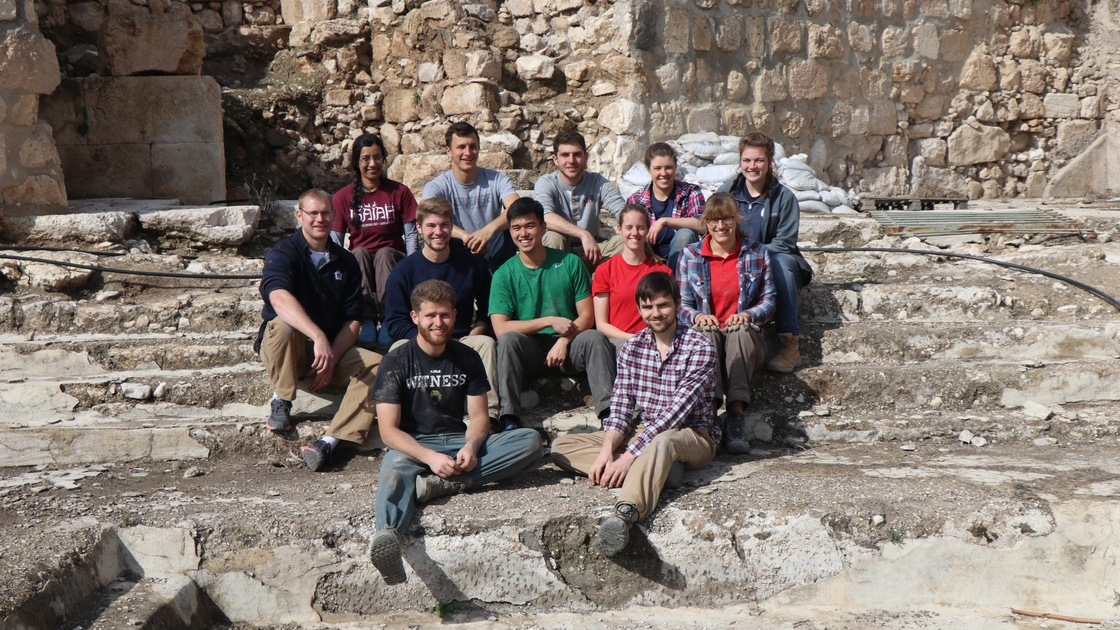JERUSALEM—A “fly on the Byzantine wall” south of the Temple Mount has been witnessing a flurry of activity at an archaeological dig site in recent weeks. Since January 15, Dr. Eilat Mazar, 11 Herbert W. Armstrong College students and graduates, and 11 Israeli workers have been excavating a site on the Ophel. So far, each day on the dig site has brought something new and different, whether it’s constructing staircases, sorting sand bags, staging equipment, hefting stones, or passing buckets of dirt.
In December, Herbert W. Armstrong College chancellor and Armstrong International Cultural Foundation chairman Gerald Flurry announced that the foundation would sponsor a total of $500,000 to help Dr. Mazar complete her second phase of excavation at the eastern edge of the Ophel. The sponsorship consists of a $300,000 donation and an estimated $200,000 sponsorship for travel, accommodations and other expenses of seven students and four graduates from Herbert W. Armstrong College to provide manpower.
“This excavation represents a big step up for the foundation,” said college president and foundation vice president Stephen Flurry. “Since 2006, we have provided Dr. Mazar with 55 volunteer diggers for six different excavations in Jerusalem—two in the City of David and four on the Ophel. The 2018 Ophel excavation, however, is the first time the foundation has provided volunteers and funded the overall costs for the dig.”
Each morning, the men leave their apartment at 5:40 a.m., arriving a couple of minutes later at the apartment that the women share with Jerusalem office manager Brent Nagtegaal and his family. At 5:45, the women join the men for the 40-minute walk winding along train tracks, through the Valley of Hinnom and beside the outer walls of the Old City to the dig site; they arrive at the excavation site by 6:30.
Junior Brianna Weeks said being at a dig site that she heard so much about growing up is “surreal” and “overwhelming.” Junior Kassandra Verbout said, “Being around so much history and potential finds is incredible. A few times, especially the first few days, I just had to stop, look around, and think about where I was actually standing.” She said her favorite thing to do upon arriving at the job site is to look at the Mount of Olives as the sun rises.
Sophomore Warren Reinsch described approaching the excavation: “When we first arrived at the Ophel site, we walked across a wooden bridge. Old stone ruins from the Byzantine period line both sides of the bridge. To the right is the massive southern wall of the Temple Mount, which contains large stone bricks, some the size of minivans.”
After workers finished preparing the site, they began to excavate. In the first week, the group removed tons of modern material: trash, dirt and an abundance of rocks. Senior Rachael Grellet said that excavating through the modern layers gave the workers “a chance to learn the basic practices of archaeological excavation before we get to the important layers where we hope to find First Temple period remnants.”
After two hours of work, a bell rings at 8:30 sharp for a hafsekah (break), 15 minutes for the team to share coffee or tea, biscuits and discussion in English and in Hebrew. After the bell rings again, students Justice Brown, Brianna Weeks, Rachael Grellet and Warren Reinsch resume work at the Area M cave, a 45-foot-by-20-foot cavern at least 20 feet deep, under supervision from Nagtegaal and graduate Christopher Eames. Students Kassandra Verbout, George Haddad and Arianne Olsen, and graduates Deepika Azariah and Nicholas Irwin continue their work at Area D, excavating Byzantine ruins with area supervisors Amir and Rachel. Frequently the whole group comes together for shesheret (chains)—workers line up and pass buckets of dirt and rocks and bags of sand from person to person.
After a 30-minute lunch at 11 a.m., the workers excavate and shesheret more material, moving further and further downward, back through the centuries, and closer and closer to what they hope will be thrilling First Temple-period discoveries.
The 2018 Ophel dig team members said they appreciate prayers for protection on the dig site, as well as guidance and wisdom while digging. Since rain has caused delays for several days, they also invite members to pray for suitable weather.
Dr. Mazar previously discovered a large structure identified as the ruins of King David’s palace (2005), evidence indicating that a wall in the City of David was built by Nehemiah (2007), two bullae belonging to princes who persecuted the Prophet Jeremiah (2008), a secret tunnel dating to the era of King David (2008), and a wall built during the reign of King Solomon (2010). Herbert W. Armstrong College students and graduates have assisted in Mazar’s excavations in the City of David (10 workers on three excavations between 2006 and 2008) and on the Ophel (34 workers on three excavations between 2009 and 2013). The relationship continues a legacy between Mazar’s grandfather, Prof. Benjamin Mazar, and Ambassador College founder Herbert W. Armstrong, which began 50 years ago in 1968.
The 2018 Ophel dig is anticipated to last from mid-January through late-March.
Listen to Dr. Eilat Mazar talk about this phase of the Ophel excavation on Episode 659 of the Trumpet Daily Radio Show.
